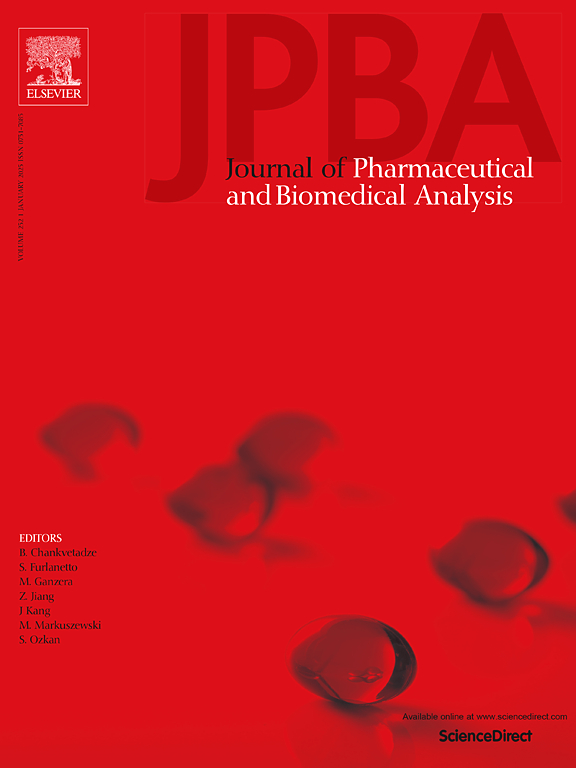Investigation of the material basis and mechanism of Qingfei Paidu granules in treating LPS-induced acute pneumonia using UPLC-Q-TOF-MS/MS, network pharmacology, molecular docking and experimental verification
IF 3.1
3区 医学
Q2 CHEMISTRY, ANALYTICAL
Journal of pharmaceutical and biomedical analysis
Pub Date : 2025-05-19
DOI:10.1016/j.jpba.2025.116973
引用次数: 0
Abstract
Qingfei Paidu granules (QFPDG), derived from four classic traditional Chinese medicine formulas with a centuries-long history of treating respiratory disorders, have shown remarkable clinical efficacy against pneumonia and lung injury, yet their pharmacodynamic components and mechanisms require further elucidation. In this work, UPLC-Q-TOF-MS/MS was used to identify the chemical constituents in QFPDG, drug-containing serum, and lung tissue. Network pharmacology was employed to predict key targets and pathways. The anti-pneumonia efficacy was evaluated via an LPS-induced acute pneumonia mouse model and by measuring cytokine levels in LPS-stimulated RAW264.7 cells. Finally, Molecular docking along with molecular dynamics simulation was conducted to explore the interactions between key compounds and targets. Results showed that 145 compounds were identified in QFPDG solution, 94 in serum, and 83 in lung tissue, with 97 components in serum and lung associated with 350 pneumonia-related targets and crucial pathways. QFPDG alleviated acute lung injury and inflammation in LPS-induced acute pneumonia mice, reducing monocyte, neutrophil, lymphocyte, and leukocyte counts in bronchoalveolar lavage fluid (BALF), as well as decreasing TNF-α and IL-1β levels. Molecular docking and molecular dynamics simulations showed that five key components in QFPDG had strong binding affinities for TNF-α, IL-1β, IL-6 and AKT1 with minimal fluctuations at equilibrium. Binding free energy calculations indicated that the ∆Gbind values ranging from −8.59 to −41.98 kcal/mol, primarily driven by hydrophobic and electrostatic interactions, involving key amino acid residues like Glu93, Tyr97, Tyr119, Gly121, and Tyr151. In summary, QFPDG presents a multi-component, multi-target approach to treating pneumonia, targeting key signaling pathways including PI3K-AKT, MAPK, and TNF. The compound-target interactions clarify its anti-inflammatory and tissue-protective mechanisms, suggesting potential for clinical application and pharmaceutical development.
采用UPLC-Q-TOF-MS/MS、网络药理学、分子对接、实验验证等方法研究清肺排毒颗粒治疗lps诱导的急性肺炎的物质基础和作用机制
清肺排毒颗粒(QFPDG)由四种治疗呼吸系统疾病的经典中药配方衍生而来,具有显著的治疗肺炎和肺损伤的临床疗效,但其药理学成分和作用机制有待进一步阐明。本工作采用UPLC-Q-TOF-MS/MS对QFPDG、含药血清和肺组织中的化学成分进行鉴定。网络药理学用于预测关键靶点和通路。通过lps诱导的急性肺炎小鼠模型和lps刺激的RAW264.7细胞因子水平来评估其抗肺炎效果。最后,通过分子对接和分子动力学模拟,探索关键化合物与靶点之间的相互作用。结果显示,在QFPDG溶液中鉴定出145种化合物,在血清中鉴定出94种,在肺组织中鉴定出83种,其中血清和肺中的97种成分与350个肺炎相关靶点和关键途径相关。QFPDG可减轻lps诱导的急性肺炎小鼠的急性肺损伤和炎症,降低支气管肺泡灌洗液(BALF)中单核细胞、中性粒细胞、淋巴细胞和白细胞计数,并降低TNF-α和IL-1β水平。分子对接和分子动力学模拟表明,QFPDG中5个关键组分对TNF-α、IL-1β、IL-6和AKT1具有较强的结合亲和力,且在平衡状态下波动极小。结合自由能计算表明,∆Gbind值在−8.59 ~−41.98 kcal/mol之间,主要由疏水和静电相互作用驱动,涉及Glu93、Tyr97、Tyr119、Gly121和Tyr151等关键氨基酸残基。总之,QFPDG提供了一种多组分、多靶点的治疗肺炎的方法,靶向包括PI3K-AKT、MAPK和TNF在内的关键信号通路。化合物-靶点相互作用阐明了其抗炎和组织保护机制,提示了临床应用和药物开发的潜力。
本文章由计算机程序翻译,如有差异,请以英文原文为准。
求助全文
约1分钟内获得全文
求助全文
来源期刊
CiteScore
6.70
自引率
5.90%
发文量
588
审稿时长
37 days
期刊介绍:
This journal is an international medium directed towards the needs of academic, clinical, government and industrial analysis by publishing original research reports and critical reviews on pharmaceutical and biomedical analysis. It covers the interdisciplinary aspects of analysis in the pharmaceutical, biomedical and clinical sciences, including developments in analytical methodology, instrumentation, computation and interpretation. Submissions on novel applications focusing on drug purity and stability studies, pharmacokinetics, therapeutic monitoring, metabolic profiling; drug-related aspects of analytical biochemistry and forensic toxicology; quality assurance in the pharmaceutical industry are also welcome.
Studies from areas of well established and poorly selective methods, such as UV-VIS spectrophotometry (including derivative and multi-wavelength measurements), basic electroanalytical (potentiometric, polarographic and voltammetric) methods, fluorimetry, flow-injection analysis, etc. are accepted for publication in exceptional cases only, if a unique and substantial advantage over presently known systems is demonstrated. The same applies to the assay of simple drug formulations by any kind of methods and the determination of drugs in biological samples based merely on spiked samples. Drug purity/stability studies should contain information on the structure elucidation of the impurities/degradants.

 求助内容:
求助内容: 应助结果提醒方式:
应助结果提醒方式:


